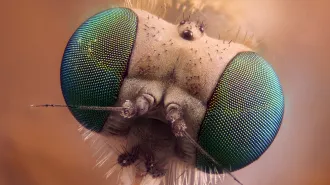Hear the caterpillar and ant sounds

A Maculinea rebeli butterfly rests on a cross-leaved gentian. Caterpillars of this butterfly feed on this plant before they trick ant larvae into caring for them. courtesy of Jeremy Thomas

That regal tone works even on ants.
A kind of European caterpillar can garner royal treatment from ants by mimicking the ch-ch-ch-ch of their queen, says an international research team.
Ants of the species Myrmica schencki can be fooled into carrying certain caterpillars into the colony nurseries where the fakers enjoy full care and five-star dining, explains Jeremy Thomas of the University of Oxford in England. An interloper caterpillar gains most of its body mass while luxuriating in ant care, and then turns into a Maculinea rebeli butterfly.
Chemical camouflage alone will let the caterpillars game their way into the ant colony. Now experiments show that the noises the caterpillars make get them the premium treatment, Thomas says. The rhythmic caterpillar purring has the effect of the queen ant’s noises, not those of a worker, Thomas and his colleagues report in the Feb. 6 Science.
It’s news that a queen sounds different from workers in an ant colony, Thomas says. Ants have such remarkable chemical messaging systems that their noises haven’t received much scientific attention.
“I haven’t been this excited about a paper in a long time,” says tropical butterfly ecologist Phil DeVries of the University of New Orleans. He made the first recordings of caterpillar calls, which he says occur only in groups that have some kind of relationship with ants.
M. rebeli caterpillars make a mini version of the brrrrrr of a woodcock or snipe, Thomas says. Recent work has suggested that caterpillar noises may come from repeated muscle spasms. And when caterpillars become enclosed pupae, they make noises by rubbing a scraper, or plectrum, on their abdomen against a patch of fine grooves called a file. “Actually they can wriggle their abdomen quite a bit,” Thomas says.
Adults of four of the 11 ant subfamilies also make noises by rubbing plectrum and file, Thomas says. “It’s rather like strumming a guitar.” In a quiet room of ants, he can just manage to hear “quite a scratchy sound,” he says.
Advances in miniature electronics made the new study possible. Specially built ant-scale microphones and speakers allowed researchers to record both queen and worker ants under normal conditions and then play back the noises and observe ant behavior.
To a human ear, queens and caterpillars don’t sound at all similar, Thomas warns. Yet ants perceive noises differently, picking up vibrations with sensors in the legs. “There is a debate about how well, if at all, they perceive airborne sounds,” he says.
When he and his colleagues played the caterpillar recordings to an ant colony, workers reacted as they do to queen scratchings. Most distinctive was what Thomas describes as on-guard attendance. Clustering around the speaker, worker ants stay motionless in a hunched-over posture with antennae out and jaws slightly open. Like an honor guard around a human queen, worker ants will maintain that pose for hours.
Queen-mimicry could explain the VIP treatment caterpillars receive in the ant colony. “Quite often they’re treated as superior beings,” Thomas says. In a crisis, worker ants rescue caterpillars before a regular ant brood. And in famine, workers will kill their own brood and feed it to the caterpillar.
The “voice” works.
|
|
||||||
|
|
Volume increased for human hearing. Audio files: Courtesy of Francesca Barbero. Caterpillar image: Jeremy Thomas. Remaining images: AAAS/Science







